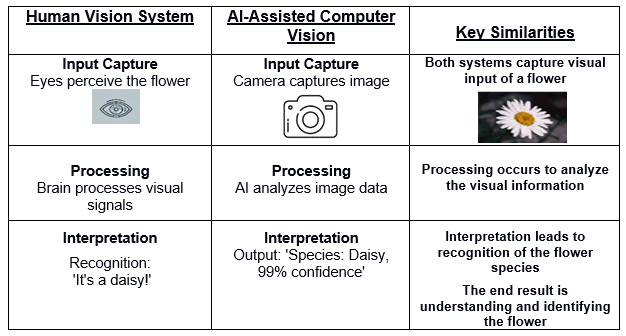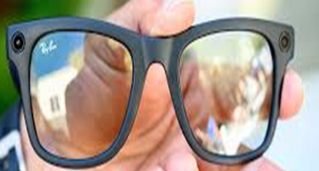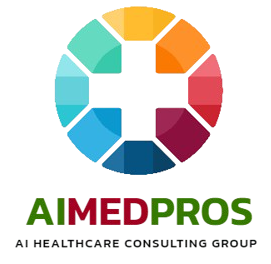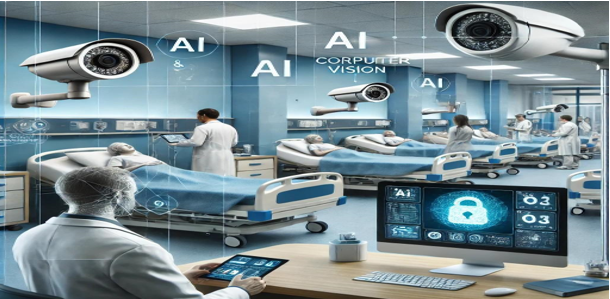Introduction
The integration of artificial intelligence (AI) within computer vision has created powerful vision reasoning tools poised to redefine healthcare delivery in all aspects. Today, we propose to explore the advances impacting the nursing and administrative processes. Indeed, recent breakthroughs in AI, particularly in large language models (LLMs) like GPT-4, combined with advanced computer vision capabilities, are opening new frontiers in healthcare.
These new Vision Reasoning Systems (VRS) can process and understand all types of visual information, make decisions, and initiate actions automatically based on their observations, paving the way for a new era of intelligent healthcare delivery. These Vision Reasoning Systems will significantly increase output per worker, and enhance productivity thereby reducing healthcare costs, reaching a better outcome, alleviating administrative burdens on healthcare workers, and improving patient safety.
From Image Capturing to Vision Reasoning
Just as the human brain recognizes, interprets, understands, and classifies objects through signals from the eyes, computer vision systems with the aid of AI recognize and classify objects by analyzing visual data from camera lenses and other sensors. Powered by algorithms trained on huge datasets, computer vision can now implement processes like recognition, categorization, and interpretation.

Figure 1. Process of detecting and interpreting images
Both human vision and computer vision involve capturing visual information, analyzing and interpreting that information by comparing it to known patterns, to recognize and understand the objects and scenes being perceived. That is why we identify this powerful capability of AI visual perception as vision reasoning. [1]
Example of hardware (AI-powered cameras) presently available in the market:

Figure 2. Ray-Ban Meta Smart Glasses
AI-powered cameras come in many forms, from home to industrial size. An interesting recent addition is the personal Ray-Ban Meta Smart Glasses. These have a built-in camera, microphones, speakers, Wi-Fi, and AI connectivity. The glasses enable users to take pictures and videos hands-free by simply speaking commands. Currently, the glasses are used for taking photos and videos hands-free, sending text messages, and listening to incoming texts. As AI capabilities continue to evolve, these glasses will likely find uses in healthcare. Upcoming features will allow users to ask the AI to identify objects in their surroundings via the camera, search the web, and chat verbally with models such as ChatGPT.
Vision Reasoning System in Healthcare
AI-powered vision reasoning systems employ cutting-edge algorithms, including convolutional neural networks (CNNs) and deep learning, to analyze medical images, monitor patients, and automate administrative tasks. These versatile systems can be deployed in various healthcare settings, offering a wide range of applications, such as:
- Clinical Care – Medical Imaging Analysis and Diagnosis: In radiology, computer vision algorithms have demonstrated high precision in detecting tumors in brain and lung scans, sometimes surpassing human performance in specific tasks [2].
- Nursing Care – Patient Monitoring: Vision Reasoning Systems can assist in continuous patient monitoring, detecting falls, assessing mobility, and even recognizing signs of delirium or pain [4].
- Data Management -Administrative Task Automation: Many healthcare professionals are spending as much time on documentation as they do on direct patient care [3]. Intelligent Vision Reasoning Systems can streamline documentation processes and ensure compliance monitoring [5].
Enhancing Patient Safety Through Continuous Monitoring
One of the most significant advantages of Vision Reasoning Systems is their ability to provide round-the-clock patient monitoring. By continuously analyzing patient movements, vital signs, and overall condition, these systems can identify changes or anomalies in real time, triggering immediate alerts to medical staff when necessary [6].
Moreover, Vision Reasoning Systems can automate the monitoring process, reducing the need for constant human oversight and minimizing the risk of human error or fatigue [8]. This not only enhances patient safety but also frees up valuable time for healthcare professionals to focus on direct patient care and other critical tasks.
Example of Visual Reasoning Systems Applications
Hospitals Settings
- ICU Nursing – Continuous Monitoring: Provide round-the-clock patient surveillance, identifying changes in movement, and behavior. These systems can detect patient distress, falls, or unauthorized bed exits, triggering immediate alerts to medical staff [6].
- ICU Nursing – Real-Time Health Tracking: From across the room these systems can read and interpret various charts, graphs, gauges, screen monitors, and even transcribe text from less than perfectly legible images. They can continuously monitor vital signs, movements, and overall condition, allowing for immediate detection of anomalies to ensure timely medical intervention [7].
- Post-Surgical Care: The Vision Reasoning System can monitor mobility in post-surgical patients, reducing the need for frequent in-person visits and enhancing recovery outcomes [8].
- ICU Nursing – Early Detection of Medical Emergencies: By analyzing subtle physiological changes and patient movements, Vision Reasoning Systems can recognize signs of medical emergencies such as seizures, respiratory distress, or cardiac events, enabling timely intervention and potentially saving lives [7].
- Virtual Triage: In mass casualty situations, either in Military Medicine or unfortunately in violent urban settings, triage is an important process to concentrate precious medical aid to that segment of patients who need it for survival. The AI-assisted advanced camera systems help prioritize patients based on visual assessments, streamlining the triage process in virtual care settings and optimizing resource allocation [15].
Virtual Consultations – Telemedicine:
- Diagnostic Assistance: AI algorithms analyze medical images captured by cameras, aiding in the detection of conditions like skin disorders or assisting in preliminary diagnosis by providing high-resolution images and real-time analysis [13].
- Enhanced Patient Interaction: Vision Reasoning Systems can analyze patient expressions and body language during virtual consultations, providing additional insights into the patient’s condition and improving the quality of remote healthcare delivery [14].
Streamlining Administrative Tasks and Reducing Costs
In addition to improving patient safety, Vision Reasoning Systems can significantly streamline administrative tasks in healthcare settings.
Capturing Facility Usage – By automatic documentation of patient activities, drug administration, and compliance with treatment protocols, these systems generate accurate and detailed patient records, reducing the administrative workload on healthcare staff [9].
Resource Allocation Optimization – Vision Reasoning Systems can be used to optimize resource allocation by monitoring patient behavior and room occupancy, identifying when rooms are ready for cleaning or when patients require additional assistance [10].
Better Outcome through Adherence to Protocols – They can also track adherence to hygiene protocols, such as handwashing and the use of personal protective equipment (PPE), ensuring compliance with regulatory standards and facilitating quality control reporting [11].
Direct Cost Savings – The automation of surveillance and documentation tasks translates into significant cost savings by reducing the need for a large administrative workforce [12]. Additionally, the consistent and accurate observations provided by AI systems minimize the risk of human errors in monitoring and documentation [13], further improving efficiency and cost-effectiveness in healthcare delivery [14].
Case Studies and Real-world Applications
Several healthcare facilities have already begun implementing AI-enabled camera systems, with promising results. For instance, a study at Sheba Medical Center in Israel found that an AI-powered fall detection system reduced falls by 35% and fall-related injuries by 20%. During the COVID-19 pandemic, Sheba Medical Center, for example, used such systems to monitor COVID-19 patients in isolation wards, reducing the risk of virus transmission to healthcare workers. [15].
Similarly, Lucile Packard Children’s Hospital at Stanford introduced an advanced way to track hand hygiene. Every year, more people die from nosocomial or hospital-acquired infections than from car accidents. The VRS uses depth sensors that can’t see the people’s faces but can still tell what they’re doing.
Challenges and Cost Considerations
While the benefits are substantial, there are important financial considerations to address:
- Cost: A basic Vision Reasoning System can cost between $50,000 to $100,000 to set up, with larger systems having additional hardware and more advanced AI features costing even more. However, the cost of implementing smaller AI-enabled vision systems is dropping dramatically. Soon, the cost to set up, maintain, and support a VRS for a private clinic is expected to fall below $1,000 per month. This development will allow healthcare providers and patients to utilize these advanced tools through cloud servers via their smartphones, computers, or smart home devices like Amazon’s Alexa.
- Data Privacy and Security: Ensuring patient privacy and data security is paramount. Healthcare providers must implement robust security measures to protect sensitive information collected by AI-enabled cameras, complying with regulations such as HIPAA in the United States.
- Integration with Existing Systems: Seamlessly integrating AI-enabled cameras with existing healthcare IT infrastructure can be challenging. Interoperability and compatibility must be addressed to ensure smooth operation.
Conclusion
Cameras with vision reasoning capabilities are redefining healthcare by enhancing patient monitoring, streamlining administrative tasks, and reducing costs. These systems improve efficiency and accuracy, ultimately leading to better patient outcomes and a more efficient and more effective healthcare delivery system. As technology continues to advance, the potential applications and benefits of AI in healthcare will expand, solidifying its position as an essential tool for modern healthcare providers. However, addressing data-security-related challenges and system integration is needed for successful implementation and widespread adoption.
Additionally, ethical considerations play a key role in the deployment of AI vision systems in healthcare. Patient privacy and consent must be rigorously protected, especially when dealing with sensitive medical imagery. Furthermore, maintaining human oversight and decision-making in critical diagnoses is essential to prevent over-reliance on machine systems and to safeguard against potential biases in the algorithms. As AI vision systems become more prevalent in healthcare, it’s imperative to develop comprehensive ethical guidelines and regulatory frameworks that balance innovation with patient rights and safety.

